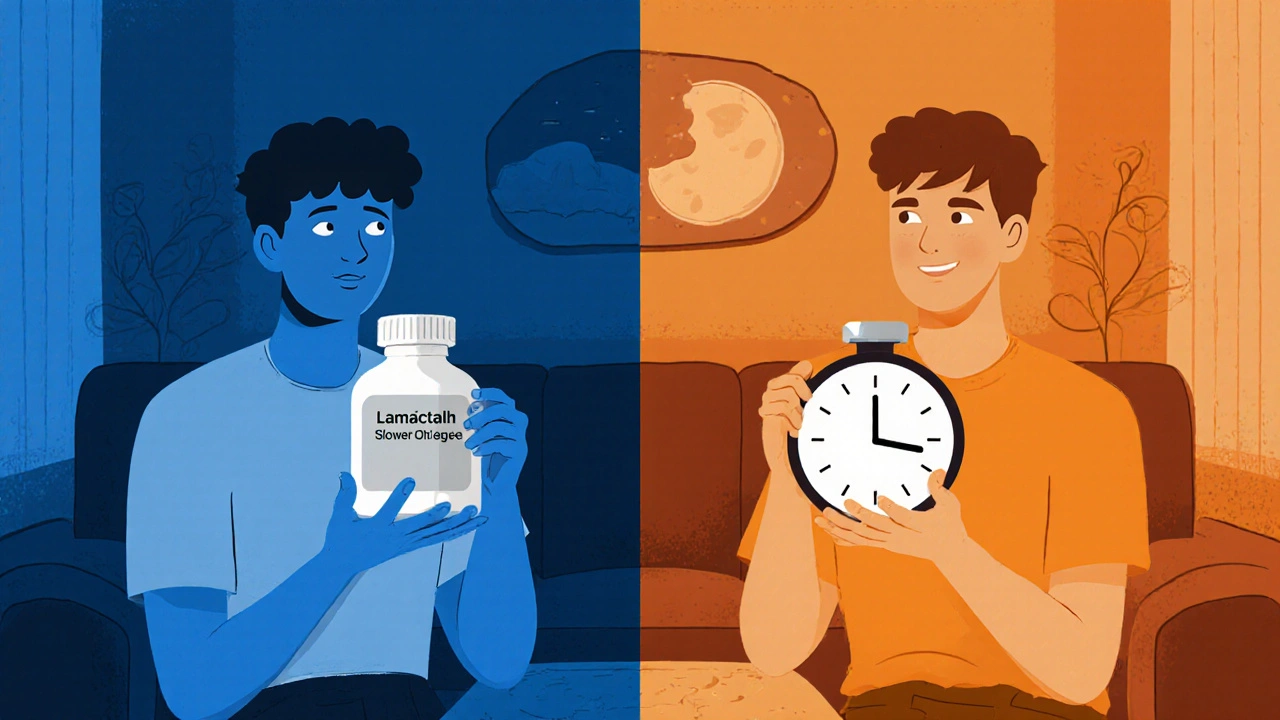Mood Stabilizer Selector
Select Your Symptoms and Preferences
If you or a loved one are navigating bipolar disorder or epilepsy, you’ve probably heard the name Lamictal (Lamotrigine). But how does it really stack up against the other pills on the shelf? This guide breaks down the science, the side‑effects, and the practical realities so you can decide which drug fits your life best.
TL;DR - Quick Takeaways
- Lamictal shines for long‑term mood stability with fewer weight‑gain issues than many alternatives.
- Valproate offers fast seizure control but carries higher liver‑toxicity risk.
- Lithium remains the gold‑standard for classic bipolar episodes, yet demands regular blood checks.
- Carbamazepine and Oxcarbazepine work well for mixed‑type mood swings, but can trigger skin rashes.
- Second‑generation antipsychotics like Quetiapine add sedation, useful for insomnia‑heavy patients.
What Is Lamictal (Lamotrigine)?
Lamictal is a broad‑spectrum anticonvulsant that was first approved by the FDA in 1994. Its primary medical uses are:
- Maintenance therapy for bipolar I and II disorders.
- Adjunctive treatment for focal and generalized seizures.
The drug works by inhibiting voltage‑gated sodium channels, which dampens the excessive neuronal firing that underlies both seizures and mood spikes.
Key Benefits and Common Side‑Effects
When you compare Lamictal to other mood stabilizers, a few points stand out:
- Low risk of weight gain - most patients report stable weight.
- Gradual onset of mood‑stabilizing effect (4-6 weeks), which can be a drawback for acute manic episodes.
- Rare but serious Stevens‑Johnson syndrome (SJS) if titrated too quickly.
- Generally well‑tolerated gastrointestinally; mild nausea is the most common complaint.

Popular Alternatives to Lamictal
Below are the most frequently prescribed drugs that patients consider when Lamictal isn’t a perfect fit.
Valproate (brand name Depakote)
Valproate is a heavy‑duty anticonvulsant and mood stabilizer. It works by increasing GABA levels and blocking sodium channels, giving it fast‑acting seizure control and strong anti‑manic properties.
Carbamazepine (brand name Tegretol)
Carbamazepine also targets sodium channels. It’s particularly useful for mixed‑type bipolar symptoms and partial seizures. Watch out for drug‑interaction potential and possible hyponatremia.
Lithium
Lithium is the oldest mood stabilizer, acting on multiple neurotransmitter pathways. It’s unrivaled for preventing both manic and depressive episodes but requires regular blood‑level monitoring to avoid toxicity.
Quetiapine (brand name Seroquel)
Quetiapine is an atypical antipsychotic that also functions as a mood stabilizer. It’s often chosen when insomnia or psychotic features accompany bipolar disorder. Sedation and metabolic effects are common side‑effects.
Oxcarbazepine (brand name Trileptal)
Oxcarbazepine is a derivative of carbamazepine with a cleaner side‑effect profile. It reduces the risk of blood‑cell disorders, yet still carries a small chance of rash.
Topiramate (brand name Topamax)
Topiramate is an anticonvulsant that also aids weight loss, making it attractive for patients struggling with medication‑induced weight gain. Cognitive “brain‑fog” is the most reported downside.
Gabapentin (brand name Neurontin)
Gabapentin is primarily used for neuropathic pain but is occasionally prescribed off‑label for mood stabilization. It has a gentle side‑effect profile but limited evidence for efficacy in bipolar disorder.
Side‑by‑Side Comparison Table
| Drug | Primary Indication | Onset of Mood Stabilization | Weight Impact | Major Side‑Effects | Monitoring Needed |
|---|---|---|---|---|---|
| Lamictal | Bipolar maintenance, seizures | 4‑6 weeks | Neutral | Rash (rare SJS), dizziness | Baseline labs; no routine levels |
| Valproate | Manic episodes, generalized seizures | 1‑2 weeks | Weight gain (moderate) | Liver toxicity, tremor, PCOS | Liver function, CBC |
| Carbamazepine | Mixed bipolar, focal seizures | 2‑4 weeks | Neutral | Hyponatremia, rash, drug interactions | CBC, sodium, liver enzymes |
| Lithium | Classic bipolar I/II | 2‑4 weeks | Neutral to mild weight gain | Thyroid, kidney, tremor, toxicity | Serum lithium levels every 1‑3 months |
| Quetiapine | Bipolar depression, psychosis | 1‑2 weeks | Weight gain (moderate‑high) | Sedation, metabolic syndrome | Fasting glucose, lipids |
| Oxcarbazepine | Partial seizures, mood swings | 3‑5 weeks | Neutral | Rash, hyponatremia (less than carbamazepine) | Serum sodium, CBC |
| Topiramate | Seizures, weight loss adjunct | 4‑6 weeks | Weight loss | Cognitive slowing, kidney stones | Kidney function, bicarbonate |
| Gabapentin | Neuropathic pain, off‑label mood | Variable | Neutral | Dizziness, edema | None routine |
How to Choose the Right Option
Every drug has a sweet spot. Ask yourself these questions before settling on a prescription:
- What’s the primary symptom? Acute mania leans toward Valproate or Lithium; depressive dominance favors Lamictal or Quetiapine.
- How quickly do you need relief? If you need fast control, Valproate or Quetiapine work within days, while Lamictal needs weeks.
- Are weight changes a deal‑breaker? Topiramate can shed pounds; Lithium and Quetiapine may add weight.
- Do you have liver or kidney concerns? Lithium demands kidney monitoring; Valproate stresses the liver.
- Is poly‑medication a factor? Carbamazepine is a CYP450 inducer and can lower levels of other drugs.
Bring this checklist to your psychiatrist or GP. A collaborative decision reduces trial‑and‑error and improves adherence.
Practical Tips & Common Pitfalls
- Titration matters. Starting Lamictal too fast is the #1 cause of Stevens‑Johnson syndrome. Follow the 25‑50‑100‑200 mg schedule over 6 weeks.
- Regular labs save lives. Even drugs that don’t need serum levels, like Valproate, still need liver enzymes checked every 3-6 months.
- Mind drug‑food interactions. Lithium’s level can rise with dehydration or a high‑salt diet; keep fluid intake steady.
- Don’t self‑switch. Switching from Lamictal to a sodium‑channel blocker like Carbamazepine without a wash‑out period can cause toxicity.
- Track side‑effects. Use a simple diary: date, dose, mood rating, any physical symptoms. This data guides dosage tweaks.

Frequently Asked Questions
Can I take Lamictal and Valproate together?
Yes, doctors sometimes combine them for patients who need both rapid seizure control (Valproate) and long‑term mood stability (Lamictal). However, the combo can increase the risk of liver strain, so liver function tests are recommended every 2-3 months.
Why does Lamictal take weeks to work for depression?
Lamictal’s mechanism involves gradual modulation of glutamate release, which isn’t immediate. Clinical trials show a steady rise in depressive‑symptom improvement after about 4-6 weeks of stable dosing.
Is Lithium still relevant in 2025?
Absolutely. Lithium remains the only drug proven to cut both suicide risk and long‑term mood episode recurrence. Newer guidelines still list it as first‑line for classic bipolar I, especially when patients can tolerate regular blood‑level checks.
What should I do if I develop a rash on Lamictal?
Stop the medication immediately and contact your prescriber. Even a mild rash can herald Stevens‑Johnson syndrome. A doctor will likely switch you to an alternative such as Valproate or a newer mood stabilizer.
Can Topiramate replace Lamictal for bipolar depression?
Topiramate isn’t approved for bipolar depression and evidence for efficacy is limited. It may help patients who also need weight loss, but it’s generally used alongside a proven mood stabilizer rather than as a stand‑alone substitute.
Choosing between Lamictal and its alternatives isn’t a one‑size‑fits‑all decision. By weighing symptom profile, speed of relief, side‑effect tolerance, and monitoring capacity, you can land on the medication that gives you the most stable, everyday life. Keep this guide handy, talk openly with your clinician, and remember that fine‑tuning medication is a marathon, not a sprint.

Angie Robinson
September 29, 2025 AT 16:12Lamictal's neutral weight profile is touted, but real‑world data shows a non‑trivial subset gain kilos over time.
Jennifer Wees-Schkade
October 3, 2025 AT 22:36If you’re monitoring labs, remember that baseline hepatic enzymes and CBC are advisable before initiating Lamictal, especially when combined with valproate.
Fr. Chuck Bradley
October 8, 2025 AT 05:00I can almost hear the chorus of patients sighing when they hear “four‑to‑six weeks” for onset. It feels like a cruel cliffhanger in a soap opera, where the hero finally shows up after a season‑long wait. Patience is a virtue, but the wait can feel punitive for those battling depressive lows.
Patrick Rauls
October 12, 2025 AT 11:24Yo fam, if you need fast mania control, Valproate is the real MVP 😎.
But don’t forget Lamictal for that steady mood ride later.
Asia Lindsay
October 16, 2025 AT 17:48Great point about titration, and the rash warning can’t be stressed enough 🚩.
Keep a diary and share it with your doc to catch any early signs.
Patrick Hendrick
October 21, 2025 AT 00:12Lamictal’s neutral weight effect makes it a top choice for many.
abhishek agarwal
October 25, 2025 AT 06:36For patients with liver concerns, skip Valproate and consider Oxcarbazepine; it’s lighter on hepatic enzymes and still offers decent mood stabilization.
Michael J Ryan
October 29, 2025 AT 12:00A quick tip: when you write down your side‑effects, use a table with columns for date, dose, symptom, and severity.
This structure lets both you and your psychiatrist spot patterns fast.
It’s a simple hack that saves a lot of guesswork.
Khalil BB
November 2, 2025 AT 18:24The mind seeks equilibrium; medications are merely the scaffolding that supports that quest.
Keri Shrable
November 7, 2025 AT 00:48Picture your brain as a garden-Lamictal is the gentle rain that waters the seedlings without flooding the whole plot.
Destiny Hixon
November 11, 2025 AT 07:12Don’t be fooled by fancy branding; the drug’s chemistry is the same worldwide, and the side‑effects don’t care about borders.
mike brown
November 15, 2025 AT 13:36Everyone raves about lithium’s anti‑suicidal effects, yet many never mention the kidney damage risk.
shawn micheal
November 19, 2025 AT 20:00I’ve seen friends switch from Lamictal to Quetiapine after months of feeling “blah.”
The sleep aid property of Quetiapine helped them get back on schedule, but the weight gain was a trade‑off.
It’s all about personal priorities.
Talk to your prescriber about a trial period and monitor your weight.
Stephen Jahl
November 24, 2025 AT 02:24The pharmacodynamic profile of lamotrigine, characterized predominantly by voltage‑gated sodium channel inhibition, engenders a modulatory effect upon excitatory neurotransmission that is both temporally protracted and quantitatively modest.
Consequently, the therapeutic latency of approximately four to six weeks is not merely an arbitrary clinical observation but a direct corollary of synaptic remodeling kinetics.
From a neuropharmacological standpoint, this latency distinguishes lamotrigine from agents such as valproate, whose augmentation of γ‑aminobutyric acid (GABA) transmission yields a more rapid attenuation of hyperexcitability.
Nevertheless, the nefarious potential for cutaneous adverse reactions, notably Stevens‑Johnson syndrome, imposes a non‑negotiable titration schema that is rigorously codified in prescribing guidelines.
Empirical evidence underscores the necessity of incremental dose escalation at bi‑weekly intervals, commencing at twenty‑five milligrams in the initial week for patients concomitantly receiving valproate.
The synergistic inhibition of hepatic glucuronidation by valproate precipitates elevated lamotrigine plasma concentrations, thereby magnifying the rash risk.
In clinical practice, baseline hepatic function panels and periodic complete blood counts constitute the minimal laboratory surveillance requisite for lamotrigine monotherapy.
When juxtaposed with lithium, whose therapeutic window is delineated by serum concentrations between 0.6 and 1.2 mmol/L, lamotrigine obviates the need for frequent serum monitoring, thereby enhancing patient adherence.
However, lithium’s superior efficacy in prophylaxis of both manic and depressive episodes remains substantiated by meta‑analyses, a nuance that must be weighted in formulary decisions.
For patients presenting with comorbid obesity, the neutral weight profile of lamotrigine is advantageous relative to second‑generation antipsychotics such as quetiapine, which are frequently implicated in metabolic syndrome.
Conversely, for individuals requiring rapid amelioration of acute manic symptomatology, the pharmacokinetic constraints of lamotrigine render it suboptimal, directing clinicians toward agents with faster onset, exemplified by valproate or atypical antipsychotics.
The heterogeneity of bipolar phenotypes necessitates a personalized algorithmic approach that integrates symptom predominance, comorbid medical conditions, and patient preference.
In this algorithmic framework, lamotrigine occupies a pivotal node as the preferred maintenance therapy for bipolar II depression, contingent upon tolerability.
Clinical decision support tools often incorporate the Drug–Drug Interaction (DDI) matrix, which flags contraindications such as concurrent carbamazepine therapy due to enzyme induction.
Patient education on the insurgent nature of cutaneous eruptions must be emphasized, with explicit instructions to discontinue the medication at the first sign of rash.
In summation, lamotrigine embodies a balance of efficacy, safety, and convenience that, when judiciously applied, can substantially mitigate the morbidity associated with bipolar disorder.
gershwin mkhatshwa
November 28, 2025 AT 08:48Nice rundown, especially the table at the end.
I’ll keep it handy for my next appointment.